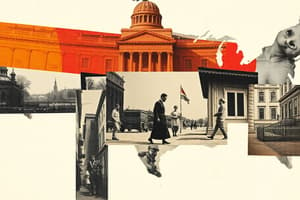Podcast
Questions and Answers
Which of the following distinguishes primary sources from secondary sources in historical research?
Which of the following distinguishes primary sources from secondary sources in historical research?
- Primary sources offer interpretations of past events, while secondary sources present firsthand accounts.
- Primary sources provide firsthand accounts or evidence from an event, while secondary sources analyze and interpret these sources. (correct)
- Primary sources are less biased than secondary sources due to their direct connection to the past.
- Primary sources are created after historical events, while secondary sources are created during the events.
When analyzing a historical event, why is understanding the historical context crucial?
When analyzing a historical event, why is understanding the historical context crucial?
- It explains the motivations and actions of individuals and groups involved. (correct)
- It helps to simplify complex events into easily understandable narratives.
- It ensures that modern values are applied when interpreting past actions.
- It allows historians to ignore potential biases in primary sources.
What does historiographical analysis primarily involve?
What does historiographical analysis primarily involve?
- Examining and comparing different interpretations of the same historical event or period. (correct)
- Creating a single, definitive narrative of a historical event.
- The physical examination and dating of historical artifacts.
- Focusing solely on primary sources to avoid biased secondary interpretations.
How can a historian best address potential biases in historical accounts?
How can a historian best address potential biases in historical accounts?
What is the most significant consideration when evaluating the historical significance of an event?
What is the most significant consideration when evaluating the historical significance of an event?
Why do historical periods and eras often have overlapping transitions?
Why do historical periods and eras often have overlapping transitions?
Historical narratives are constructed by various groups and individuals. What does this imply about historical truth?
Historical narratives are constructed by various groups and individuals. What does this imply about historical truth?
Which research method allows historians to create a more complete and nuanced picture of the past?
Which research method allows historians to create a more complete and nuanced picture of the past?
Flashcards
Historical Periods
Historical Periods
Categories dividing history into significant time frames, e.g., ancient or modern.
Primary Sources
Primary Sources
Firsthand accounts or evidence from historical events, like letters or photos.
Secondary Sources
Secondary Sources
Works that interpret or analyze primary sources, such as books or articles.
Historical Research Methods
Historical Research Methods
Signup and view all the flashcards
Historical Bias
Historical Bias
Signup and view all the flashcards
Historical Context
Historical Context
Signup and view all the flashcards
Historical Significance
Historical Significance
Signup and view all the flashcards
Historical Narratives
Historical Narratives
Signup and view all the flashcards
Study Notes
Historical Periods and Eras
- History encompasses all past events, from early civilizations to present-day issues.
- Historians divide time into periods (ancient, medieval, modern, etc.) based on major cultural and political shifts.
- These periods are not fixed; transitions often overlap.
- Studying historical periods reveals the chronological development of societies.
Primary Sources
- Primary sources are firsthand accounts or evidence from historical events.
- Examples include letters, diaries, photographs, government documents, and artifacts.
- Primary sources are vital for understanding the past firsthand.
- They provide unique perspectives absent in secondary sources.
Secondary Sources
- Secondary sources analyze and interpret primary sources or other historical accounts.
- Books, articles, and scholarly essays are examples.
- Secondary sources offer context and interpretation, drawing on various primary sources.
- They promote a deeper understanding of complex issues.
Historical Research Methods
- Historians employ diverse methods to study the past.
- Critical analysis of primary sources is essential, considering potential biases and limitations.
- Historiographical analysis examines differing interpretations of historical events.
- Using varied sources and methods creates a more complete and nuanced historical picture.
Historical Bias
- Historical accounts reflect the perspectives and priorities of their creators.
- Biases stem from political affiliations, social positions, and personal experiences.
- Recognizing and assessing bias is crucial for accurate historical interpretation.
- Historians aim to counteract bias through diverse perspectives.
Historical Context
- Understanding historical context is essential for interpreting events and developments.
- Political climate, social conditions, and economic factors all influence historical outcomes.
- Analyzing context illuminates motivations and actions of individuals and groups.
Historical Significance
- Immediate significance of historical events and figures may be secondary to later importance.
- Past events offer lessons and insights applicable to contemporary situations.
- Evaluating significance involves considering long-term effects and multiple interpretations.
Historical Narratives
- Historical narratives give meaning and order to past events.
- Different individuals and groups create their own narratives, often interpreting events differently.
- These narratives are shaped by societal values and understanding at the time.
Historiography
- Historiography examines historical writing itself.
- It explores changing perspectives on events and the evolution of historical methods.
- It investigates the influence of diverse schools of thought on historical interpretations.
Studying That Suits You
Use AI to generate personalized quizzes and flashcards to suit your learning preferences.




